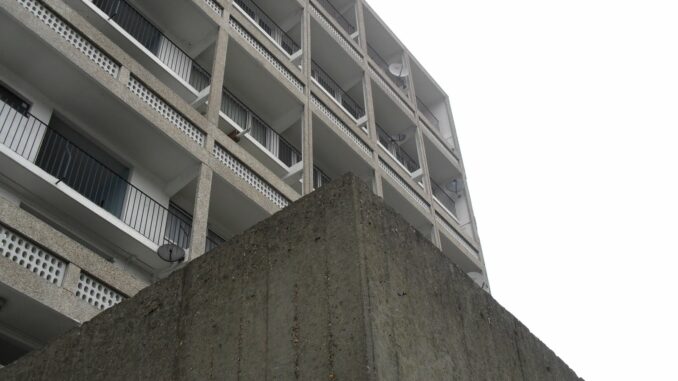
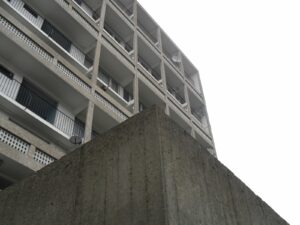
was once considered an innovative architectural style and progressive social
housing project. Surprising, because if you are unlucky enough to visit
Roehampton on a commonly overcast day you will start to develop acute
claustrophobia and depression from the grey structures that surround you. It’s
not hard to see how being surrounded by this bombardment of rough, jagged forms
would lead to a sense of hopelessness, manifested in the urine soaked lifts,
graffitied walls, stairwells with puddles of vomit, and strewn rubbish. Built in
1959 by the London County Council Architects Department to emulate the Swiss-born
Brutalist style. Using raw concrete and severe geometric forms to divide large
rectangular slabs into habitable units, the Alton West estate differed
substantially from Le Corbusier’s original vision. Whereas the Unité
d’Habitation included shops, sports, medical and educational facilities, a
public hotel, a restaurant and generous proportions, Alton West’s
stripped down version contain none of these benefits. Still, this did not stop
people flocking to live in the estate or the buildings subsequently becoming
listed!
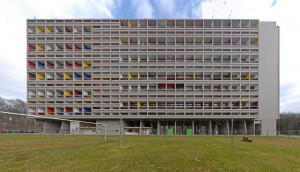
The social degeneration incased in these
concrete boxes has become a source of melancholic and nostalgic inspiration for
several contemporary painters. Nominated for the 2011 Turner Prize, George Shaw
has produced a series of paintings depicting the suburban Coventry estate he
grew up in. Using a type of enamel paint more commonly used to paint bikes or
toy models, Shaw has created a range of images which seem to warily but
romantically look back at his old stomping grounds, while capturing every detail
of urban degeneration to a precise, almost photo-realistic level.
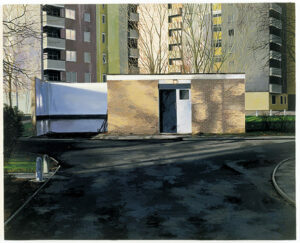
Peter Doig voyeuristically peers through the
evergreen wood at the Unite d’Habitation as though sinisterly stalking a
resident. I think it says something that the building is obscured by the trees.
We find the building as a type of fascination, a relic or monument to a
modernism that has been reconquered by the natural world. Almost like
discovering an ancient Aztec pyramid in the middle of the jungle.
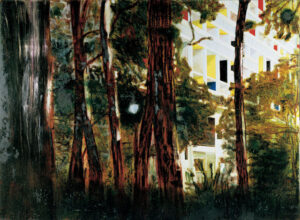
My art teacher recommended a previous
colleague of his who produces work on a similar theme. Gordon Picken has made
large paintings depicting abandoned houses, or “pavilions” as he has calls them.
Constructed from several canvases placed side by side to make up a single image,
they look like a pastiche of different styles from close up, but from a distance
they become clearly harmonious. Dilapidated, warped and bent, these structures
are distinctly separated from the surrounding landscape, but the jostling colours
and angular forms create a hive of activity. There are no people visible but the
patchwork of surfaces creates the buzz of a bustling community.
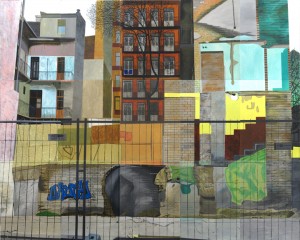
These three approaches clearly show us the
psychological effect of Brutalist architecture. Whether it is intrusive and ugly,
grand and monumental, or bustling and energetic, Brutalism is part of the urban
environment we inhabit, and an enduring cultural identity drawn upon by
contemporary artists.
https://www.open2.net/modernity/3_19.htm
https://www.guardian.co.uk/artanddesign/2011/may/04/turner-prize-shortlist-2011-announced
https://www.guardian.co.uk/artanddesign/gallery/2011/feb/13/art-george-shaw-in-pictures


Interesting theme, I enjoyed reading your view and personal experience alongside the approaches taken by your 3 selected artists.
Really fascinating subject, and I enjoy your writing and use of varied examples to illustrate your ideas. I too find the dichotomy of Brutalist architecture intriguing, the National Theatre makes another interesting case study. The epitome of Brutalism, yet a hub of vibrancy, creativity and enjoyment and a space people really love, nevertheless, stripped of its purpose I think most people would find it stark and rather foreboding.
Thanks. The Southbank is a really interesting area as you say. I have always found the Hayward gallery a bit odd because of the architecture. I also went past the Renoir cinema in Bloomsbury this weekend and the Brutalist architecture there is very weird! More space age, futuristic. Architecture has an enormous effect on us. Its very different growing up in that environment as opposed to visiting. But still two very interesting effects and points of view.
Appreciate your comments